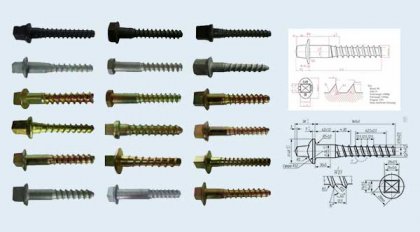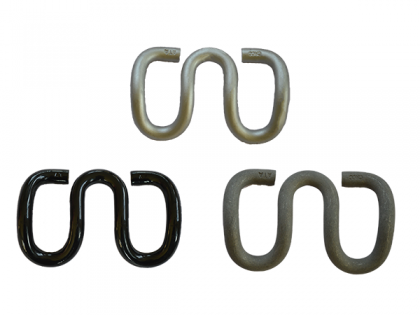Rail Pad
Rail pads, originally called sole plates, are elastic polyurethane mats assembled between steel rails and rail sleepers to protect the sleeper top from wearing and impacting. The starting stiffness of rail pads is designed not to be high so that their relative deformation under the spring clip toe loads is greatly substantial. This mechanism guarantees the rail pad maintaining in close contact with the rail despite of any vertical movements of the latter.

As a professional manufacture of rail fasteners, AGICO Rail can produce various types of rail pads for different rail standards, such as UIC54, UIC60, BS80lbs, BS100lbs, etc. Moreover, we can arrange customized production of rail pads according to drawings or samples.

As a professional manufacture of rail fasteners, AGICO Rail can produce various types of rail pads for different rail standards, such as UIC54, UIC60, BS80lbs, BS100lbs, etc. Moreover, we can arrange customized production of rail pads according to drawings or samples.
Functions of rail pads
Rail pads can reduce fatigue cracking of the concrete sleepers, which is believed to be driven by impact and vibration from the passing train. In addition, rail pads under the rail to ensure:
- Load distribution over a larger surface
- Elimination of load concentration and the resultant fatigue stresses
- Centering of loads on the supporting element
- Absorption of uneven contact surfaces between rail and support
- Reduction of noise and vibration
- Sealing between the bottom of the rail and the top of the support
- Reduction of wear of steel rail and its support

Types of materials for rail pads
After years of experience in rail pad manufacturing, we have developed a range of high-performance elastic rail pads for stiffness requirements and various application areas-from trams through standard gauge railways to heavy haul lines, especially rail pads for E-clip rail fastening systems and SKL type rail fastening systems with material of HDPE/EVA/Rubber, with following properties respectively.
HDPE
| No. | Technical Parameter | Unit | Technical Requirement | Value |
|---|---|---|---|---|
| 1 | Density | g/cm3 | 0.95-0.98 | 0.95 |
| 2 | Tensile Strength | Mpa | ≥19 | 19 |
| 3 | Elongation | % | >80 | 150 |
| 4 | Melting Point | °C | 170-190 | 190 |
| 5 | Insulation Resistance | Ω | ≥1×1010 | 3.5 ×1010 |
| 6 | Hardness | A | ≥98 | 98(A) |
EVA: Polyethylene 80%, Vinyl Acetate 20%
| No. | Technical Parameter | Unit | Technical Requirement | Value |
|---|---|---|---|---|
| 1 | Density | g/cm3 | 0.95-0.98 | 0.95 |
| 2 | Tensile Strength | Mpa | ≥15 | 16 |
| 3 | Elongation | % | >500 | 550 |
| 4 | Melting Point°C | °C | 170-190 | 170 |
| 5 | Insulation Resistance | Ω | ≥1×1010 | 5.0 ×1010 |
| 6 | Hardness | A | ≥90 | 92(A) |
Rubber
| No. | Technical Parameter | Unit | Value |
|---|---|---|---|
| 1 | Stiffness | KN | 90-130 |
| 2 | Hardness Shore A°C | °C | 72-80degree |
| 3 | Electronic Resistance | Ω | ≥ 106 |
| 4 | Tensile Strength before Aging | Mpa | ≥12.5 |
| 5 | Elongation before Aging | % | ≥250 |
In the railway system, rail pads act in two main ways: rail pads can diminish shock or impact loads by providing compliance, and they reduce (by isolation and perhaps by damping) resonant vibrations excited in the concrete sleepers (lowest resonant frequency about 200 Hz) and accommodate vibration deflections in the rail sections between the sleepers (about 0.12mm amplitude, 1000 Hz). In addition rail pads prevent rail sleeper abrasion, and crushing of the sleeper under the rail foot.
Rubber rail pads are normally designed to a specified load-deflection characteristic. The initial stiffness of the pad is designed to be low so that that their deformations under the springs toe loads is quite substantial. This ensures that the pad remains in intimate contact with the rail despite any vertical movements of the latter. When the wheel is over the pad, the latter’s stiffness must be high to prevent large movements which can result in the metal spring washer becoming loose. Such a load-deflection characteristic can be obtained by introducing grooves in the rubber pads.
Rubber rail pads are normally designed to a specified load-deflection characteristic. The initial stiffness of the pad is designed to be low so that that their deformations under the springs toe loads is quite substantial. This ensures that the pad remains in intimate contact with the rail despite any vertical movements of the latter. When the wheel is over the pad, the latter’s stiffness must be high to prevent large movements which can result in the metal spring washer becoming loose. Such a load-deflection characteristic can be obtained by introducing grooves in the rubber pads.
Manufacturing Process of rail pads
- Preparation of rubber compound
- Mixing is carried out on a two-roll mill or in an internal mixer. In the case of an internal mixer, it can be done in a single-stage or double-stage mixing where the masterbatch, which was earlier prepared in the internal mixer, is finalized by adding curatives on a two roll mill.
- Shaping and curing
- Compression or Injection moulding
- Trimming of finished products
- Ready for use

Some Main Types of Rail Pads
Rail pads for E-type rail fastening system

Rail rubber pads used for E-type rail fastening systems are with the similar functions of the rail insulators to insulate the rail above it from the tie sleepers laid below it, for effective protection against vibration and structure-borne noise as well. The rail pad works together with e-clips, rail insulators/insulated gauge blocks and rail shoulders/embedded parts to form a whole set of E-type rail fastening system.
Rail pads for SKL rail fastening system

A rail pad in a SKL rail fastening system is a small but crucial fastener part, working together with SKL clips, screw spikes, plastic dowels, guide plates and so on. The elastic rail pads we produce possess a defined stiffness and demonstrably increase the elasticity of the track superstructure. With a higher level of elasticity, it contributes towards quiet running of the rolling stock, to meet today’s acoustic requirements on railway lines.
Rubber rail pads for concrete sleepers

| Material: | Rubber |
|---|---|
| Standard: | TB/T2626-95 |
| Application: | 43kg/m ,50kg/m, 60kg/m, 75kg/m rail |
| Models: | 43-7-7, 43-10-7, 50-7-9, 50-10-9, 60-10-17, 60-12-17 |
| Operation Temperature: | -50~70 degrees |
| Certificate: | ISO9001:2008 |
| Notes: | Should be stored in clean, ventilated place. Don’t put under direct sunlight, and keep away from heat sources and chemical reagents. Don’t touch oil, organic solvent and other chemicals. |
High-elastic grooved EVA/HDPE/rubber rail pads

Our EVA/HDPE/rubber rail pads are with high elasticity, applying to types for rails such as rail UIC54, UIC60, BS80lbs, BS100lbs, and sizes as ordered. The pads can be customized with or without grooves, in various possible designs, depending on customers’ requirements.
Get In touch Now!
We receive enquiries in English, Español (Spanish), Русский язык (Russian), Français (French) and العربية (Arabic). Our professional team will reply to you within one business day. Please feel free to contact us!




